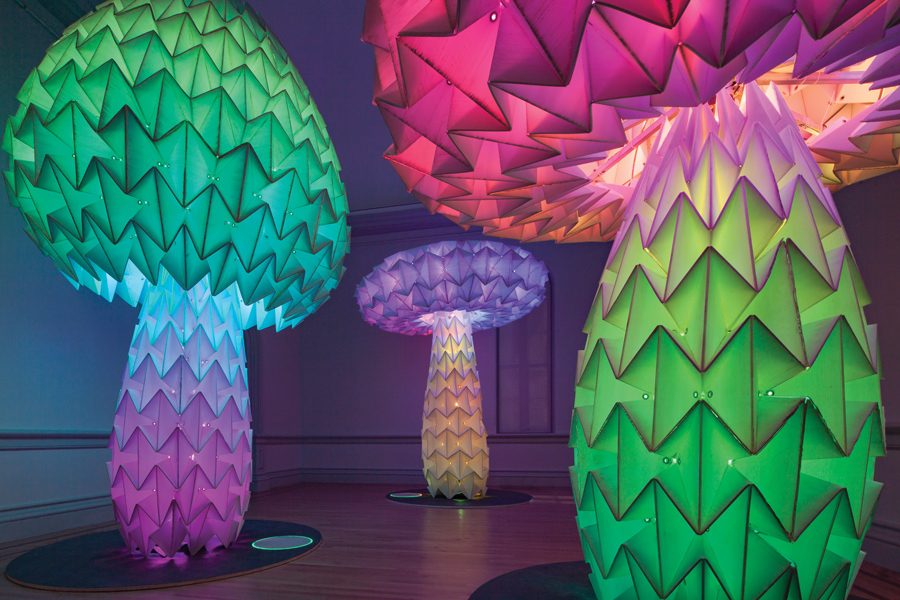Northwestern alumnus helps program light-up mushrooms for Smithsonian art installation
Source: Ron Blunt/Smithsonian American Art Museum Renwick Gallery/Foldhaus Art Collective
“Shrumen Lumen” at the Smithsonian American Art Museum’s Renwick Gallery is a part of the exhibition “No Spectators: The Art of Burning Man.” Northwestern alum Bomani McClendon contributed to this project, which is on display from March 30 to Jan. 21, 2019.
May 2, 2018
Bomani McClendon (McCormick ’17) had yet to graduate from Northwestern when he was brought on board the “Shrumen Lumen” art project as a software programmer.
Then an intern at the design company IDEO, McClendon was hand-picked by Joerg Student, executive design director at the company and lead artist for “Shrumen Lumen,” to help with coding the five 12- to 18-feet tall luminescent mushrooms to be displayed at Burning Man 2016.
Almost two years later, McClendon’s skilled work on the project is on display at the Smithsonian American Art Museum’s Renwick Gallery as part of the “No Spectators: The Art of Burning Man” exhibition, which runs until next January.
McClendon said he was brought on board the project in July 2016. With about three months until “Shrumen Lumen” was scheduled to appear at Burning Man, he worked to perfect the interactive aspects of the piece.
“From one perspective, it’s this almost alien object, but it’s also very much a mechanical construction,” McClendon said. “There’s something interesting about how those two things collide and and corroborate each other.”
Kalan Kircher (McCormick ’11), the digital lead for the project, collaborated closely with McClendon as both men worked on programming the mushrooms to move, light up and change shape depending on how observers step on a weight-sensing pad.
Kircher said he was initially drawn to McClendon as a fellow NU graduate, soon realizing the high level of skill McClendon brought to the project, especially for someone so young.
“What struck me at first is that he’s obviously very technically savvy, but also has a really good eye for design,” Kircher said. “He’s always keeping the user really at the forefront even while he is deep in the software side of development.”
Since working on “Shrumen Lumen” with McClendon, Kircher said the two have developed their relationship both personally and professionally, even traveling to Washington, D.C., and Dubai together for installations.
Student, the lead artist who works at IDEO, said he asked McClendon to help with the project because he was impressed with the energy he brought to the team at IDEO. Although many people who worked on the project were IDEO staffers, “Shrumen Lumen” is actually the brainchild of FoldHaus art collective and is unaffiliated with IDEO, he said.
Student is one of the leaders of FoldHaus, which specializes in large-scale, interactive origami art installations. He said the work on “Shrumen Lumen” was entirely volunteer-based and was often conducted at night and on weekends.
McClendon said he really valued working alongside artistic professionals and getting to develop relationships that extended beyond the workplace. McClendon, who majored in computer science, said although art is more of a hobby for him, he is interested in exploring its intersections with technology.
“I wouldn’t consider myself to be an artist, but I’ve always been interested in the ways that technology and some of the things that I have dedicated some more focused effort to could contribute to the creation of art,” he said.
Despite being brought on about halfway through the process, McClendon is considered one of the core five or six people who worked on the project, Student said.
“He was running meetings with our electronic guys and and sort of saying, ‘Come up with a game plan,’” Student said. “He wasn’t just the software guy, he really said, ‘OK, here’s the challenge, here’s the timeline we have, this is what needs to be done.’”
Email: [email protected]
Twitter: @amelialangas


